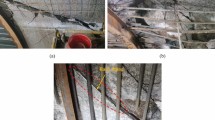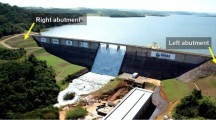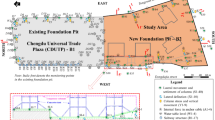Abstract
The rock plate (RP) method can be used to identify the size and location of potentially dangerous bed separation space (BSS) in coal mines. The RP method is performed in three steps: (1) The rock strata above the coal seam is simplified as a composite plate calculation model; (2) The deflection of rock strata is expressed as a double trigonometric series and obtained using the energy method; (3) The internal-forces and deformation of the RP are solved to determine the size and location of the BSS based on elasticity and a BSS identification process. This requires that the BSS be unbroken, and the BSS upper rock stratum be an aquifer. In this study, the Yuanzigou coal mine was taken as a study case and the RP method was used to determine the size and location of BSS water (BSS-W) above the coal goaf of working face 1,012,001. BSS usually occurs at the contact surface between hard and soft rock strata; at this mine, BSS-W exists between the Yijun conglomerate and the Anding mudstone formations. The results predicted that when the working face advanced 350 m, the third BSS will break, allowing BSS-W to flood into the goaf. These results were verified by borehole video observation. Therefore, two control methods were used: inclined drainage holes drilled from the roadway and spaced holes drilled from the surface in areas with abundant water. This paper thus provides a way to locate the BSS-W and prevent an inrush hazard.














Similar content being viewed by others
References
Cao HD (2018) Study on prevention & control technology and disaster-caused mechanism of bed separation water body in overburden strata during coal seam mining. PhD thesis, China Coal Research Institute, Beijing (in Chinese)
Chen SG, Guo H (2008) Numerical simulation of bed separation development and grout injecting into separations. Geotech Geol Eng 26(4):375–385. https://doi.org/10.1007/s10706-008-9174-7
Fan KF, Li WP, Wang QQ, Liu SL, Xue S, Xie CY (2019) Formation mechanism and prediction method of water inrush from separated stratas with in coal seam mining: a case study in the Shilawusu mining area. China Eng Fail Anal 103:158–172. https://doi.org/10.1016/j.engfailanal.2019.04.057
Gao F, Sang Y (2017) Water inrush from overburden strata separation reservoir and the countermeasures in Lijialou coal mine. J N Chin Inst Sci Technol 14(6):12–16 (in Chinese)
Gui HR, Lin ML, Song XM (2018) Identification and application or roof bed separation (water) in coal mines. Mine Water Environ 37(2):376–384. https://doi.org/10.1007/s10230-018-0518-0
Guo WJ, Li YY, Yin DW, Zhang SC, Sun X (2016) Mechanisms of rock burst in hard and thick upper strata and rock-burst controlling technology. Arab J Geosci 9(10):1–11. https://doi.org/10.1007/s12517-016-2596-2
He JH (2018) Dynamic evolution of bed separation in coal seam mining and assessment of bed-separation water hazards. PhD He, China Univ of Mining and Technology (in Chinese)
He JH, Li WP, Liu Y, Yang Z, Liu SL, Li LF (2018) An improved method for determining the position of overlying separated strata in mining. Eng Fail Anal 83:17–29. https://doi.org/10.1016/j.engfailanal.2017.09.015cc
Li XQ (2011) Study on the inrush mechanism of the water in bed separation due to repeated coal mining under hard rock. PhD Li, China Univ of Mining and Technology (in Chinese)
Lin Q, Qiao W (2016) Water prevention and control technology of roof bed separation in Cuimu Mine. Coal Sci Technol 44(3):129–134 (in Chinese)
Lu QY, Li XQ, Li WP, Chen W, Li L, Liu S (2018) Risk evaluation of bed separation water inrush: a case study in the Yangliu coal mine. China Mine Water Environ 37(2):288–299. https://doi.org/10.1007/s10230-018-0535-z
Ma D, Duan H, Li X, Li Z, Zhou Z, Li T (2019) Effects of seepage-induced erosion on nonlinear hydraulic properties of broken red sandstones. Tunn Undergr Sp Tech. https://doi.org/10.1016/j.tust.2019.102993
Ma D, Duan H, Liu W, Ma X, Tao M (2020a) Water–sediment two-phase flow inrush hazard in rock fractures of overburden strata during coal mining. Mine Water Environ 39(2):308–319. https://doi.org/10.1007/s10230-020-00687-6
Ma D, Duan H, Zhang Q, Zhang J, Li W, Zhou Z, Liu W (2020b) A numerical gas fracturing model of coupled thermal, flowing and mechanical effects. Comput Mater Cont 65(3):2123–2141. https://doi.org/10.32604/cmc.2020.011430
Ma D, Zhang J, Duan H, Huang Y, Li M, Sun Q, Zhou N (2021) Reutilization of gangue wastes in underground backfilling mining: Overburden aquifer protection. Chemosphere 264:128400
Miao X, Cui X, Wang J, Xu J (2011) The height of fractured water conducting zone in undermined rock strata. Eng Geol 120(1–4):32–39. https://doi.org/10.1016/j.enggeo.2011.03.009
Palchik V (2003) Formation of fractured zones in overburden due to long wall mining. Environ Geol 44(1):28–38. https://doi.org/10.1007/s00254-002-0732-7
Palchik V (2005) Localization of mining-induced horizontal fractures along rock strata interfaces in overburden: field measurements and prediction. Eng Geol 48(1):68–80. https://doi.org/10.1007/s00254-005-1261-y
Qian MG, Miao XX, Xu JL (2003) Key strata theory in ground control. China Univ of Mining and Technology press, Xuzhou (in Chinese)
Qiao W, Li WP, Li XQ (2011) Mechanism of “hydrostatic water inrush” and counter measures for water inrush in roof bed separation of a mining face. J Min Saf Eng 28(1):96–104 (in Chinese)
Qiao W, Huang Y, Yuan ZB, Guo W, Zhou DK (2014) Formation and prevention of water inrush from roof bed separation with full-mechanized caving mining of ultra-thick coal seam. Chin J Rock Mech Eng 33(10):2076–2084 (in Chinese)
Su ZJ, Yu GM, Yang L (2003) Numerical simulation on mechanism of deformation of separated strata in overburden. Chin J Rock Mech Eng 22(8):1287–1290 (in Chinese)
Wang SF, Li XB, Wang SY (2017) Separation and fracturing in overlying strata disturbed by long wall mining in a mineral deposit seam. Eng Geol 226:257–266. https://doi.org/10.1016/j.enggeo.2017.06.015
Wu LY, Bai HB, Yuan C, Wu GM, Xu CY, Du Y (2019) A water-rock coupled model for fault water inrush: a case study in Xiaochang coal mine, China. Adv Civ Eng 2019:1–12. https://doi.org/10.1155/2019/9343917
Xu JL, Qian MG, Jin HW (2004) Study and application of bed separation distribution and development in the process of strata movement. Chin J Geotech Eng 26(5):632–636 (in Chinese)
Xu JL, Wang XZ, Liu WT, Wang ZG (2009) Effects of primary key stratum location on height of water flowing fracture zone. Chin J Rock Mech Eng 28(2):380–385 (in Chinese)
Xuan DY, Xu JL (2014) Grout injection into bed separation to control surface subsidence during longwall mining under villages: case study of Liudian coal mine. China Nat Hazards 73(2):883–906. https://doi.org/10.1007/s11069-014-1113-8
Yan H, He FL, Yang T, Li LY, Zhang SB, Zhang JX (2016) The mechanism of bedding separation in roof strata overlying a roadway within a thick coal seam: a case study the Pingshuo coalfield, China. Eng Fail Anal 62:75–92. https://doi.org/10.1016/j.engfailanal.2015.12.006
Zhou ZL, Cai X, Ma D, Chen L, Wang SF, Tan LH (2018) Dynamic tensile properties of sandstone subjected to wetting and drying cycles. Constr Build Mater 182:215–232. https://doi.org/10.1016/j.conbuildmat.2018.06.056
Acknowledgements
This work was supported by the National Natural Science Foundation of China (41977238 and 51804339), the Young Elite Scientists Sponsorship by CAST, the Special Fund for the Construction of Innovative Provinces in Hunan (2019RS2007), and the China Postdoctoral Science Foundation (2019T120715 and 2018M640760).
Author information
Authors and Affiliations
Corresponding author
Supplementary Information
Below is the link to the electronic supplementary material.
Rights and permissions
About this article
Cite this article
Wu, L., Bai, H. & Ma, D. Prediction and Prevention of Water Inrush Hazards from Bed Separation Space. Mine Water Environ 40, 657–670 (2021). https://doi.org/10.1007/s10230-020-00748-w
Received:
Accepted:
Published:
Issue Date:
DOI: https://doi.org/10.1007/s10230-020-00748-w




